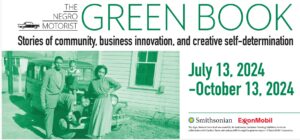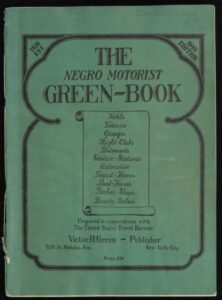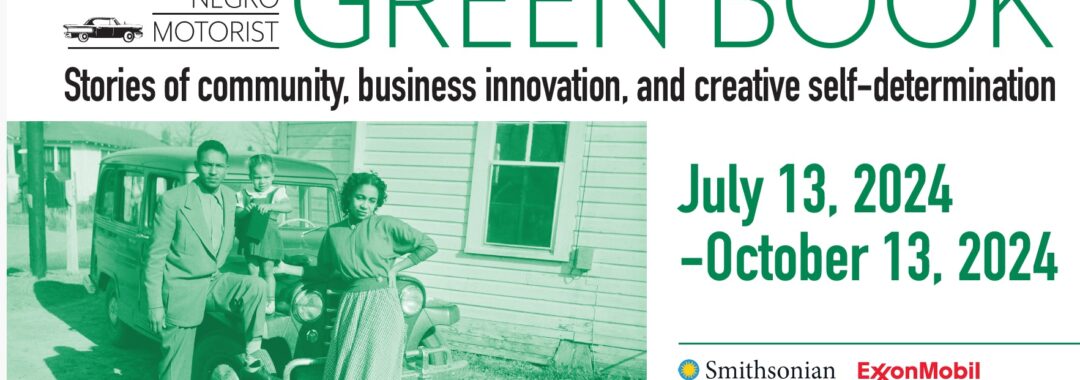April 25, 2024
Black resilience on display in upcoming Green Book exhibition
Smithsonian-produced exhibition comes to the National Underground Railroad Freedom Center July 13
CINCINNATI – The resilience and ingenuity of African Americans take center stage in a new exhibition coming to the National Underground Railroad Freedom Center. The Negro Motorist Green Book offers an immersive look at the iconic travel guide that safely guided Black travelers through segregated America in the middle of the 20th century. The featured exhibition developed by the Smithsonian Institution Traveling Exhibition Service (SITES) opens July 13.
 In the intensely, often violently, segregated America of the early 20th century, African Americans faced harassment, embarrassment and even physical violence when they traveled out of the known safety of their towns. Seeking to provide African American travelers with a reliable source of safe spaces – an “overground” railroad – Harlem postman Victor Green published a listing of restaurants, gas stations, hotels, department stores and other businesses that welcomed Black travelers. This guide, known as The Green Book, was first published in 1936 and would be annually produced and distributed nationwide until 1967. In the era of Jim Crow and “sundown towns,” the knowledge of these businesses was not just helpful, it could be lifesaving.
In the intensely, often violently, segregated America of the early 20th century, African Americans faced harassment, embarrassment and even physical violence when they traveled out of the known safety of their towns. Seeking to provide African American travelers with a reliable source of safe spaces – an “overground” railroad – Harlem postman Victor Green published a listing of restaurants, gas stations, hotels, department stores and other businesses that welcomed Black travelers. This guide, known as The Green Book, was first published in 1936 and would be annually produced and distributed nationwide until 1967. In the era of Jim Crow and “sundown towns,” the knowledge of these businesses was not just helpful, it could be lifesaving.
The Negro Motorist Green Book uses Smithsonian artifacts, from business signs and postcards to historic footage, images and firsthand accounts, to convey the apprehension felt by African American travelers and to celebrate the resilience, innovation and elegance of people choosing to live a full American existence. The exhibition brings into focus a vibrant parallel world of African American businesses, the rise of the Black leisure class and the important role The Green Book played in facilitating the second wave of the Great Migration, empowering African Americans to escape the hostility of racism across the country – particularly in the South – and pursue their American Dream.

"We’re excited to share the story of The Green Book with our community. It’s a story that transcends history because its legacy, and those who lived it, are still with us,” said Woodrow Keown, Jr., president and COO of the National Underground Railroad Freedom Center. “The Green Book is a light in a dark period in American history. It showed, as the Underground Railroad did a century earlier, that African Americans would not be denied their freedom and were prepared to prevail over the systems designed to oppress them.”
The Negro Motorist Green Book is included with museum admission and will be open from July 13 to October 13 at the National Underground Railroad Freedom Center.
The Negro Motorist Green Book was developed by SITES in collaboration with award-winning author, photographer and cultural documentarian Candacy Taylor. The exhibition was made possible through the support of Exxon Mobil Corporation whose predecessor, Standard Oil Company of New Jersey, played a significant role in the distribution of The Green Book through its U.S. network of Esso stations, helping to provide motorists and their families opportunities for safer and more comfortable travel. Esso stations were the only major retailer of The Green Book. Esso also employed many African American engineers, scientists and marketing executives and welcome African American motorists at its stations.
###
About the National Underground Railroad Freedom Center
The National Underground Railroad Freedom Center opened in August 2004 on the banks of the Ohio River in downtown Cincinnati, Ohio. Since then, more than 1.3 million people have visited its permanent and changing exhibits and public programs, inspiring everyone to take courageous steps for freedom. Two million people have utilized educational resources online at freedomcenter.org, working to connect the lessons of the Underground Railroad to inform and inspire today’s global and local fight for freedom. Partnerships include Historians Against Slavery, Polaris Project, Free the Slaves, US Department of State and International Justice Mission. In 2014, the National Underground Railroad Freedom Center launched a new online resource in the fight against modern slavery, endslaverynow.org.
About Smithsonian Institution Traveling Exhibition Service
The Smithsonian Institution Traveling Exhibition Service (SITES) has been sharing the wealth of Smithsonian collections and research programs with millions of people outside Washington, D.C., for more than 65 years. SITES connects Americans to their shared cultural heritage through a wide range of exhibitions about art, science and history, which are shown wherever people live, work and play. For exhibition description and tour schedules, visit sites.si.edu.
About ExxonMobil
ExxonMobil, one of the largest publicly traded international oil and gas companies, uses technology and innovation to help meet the world’s growing energy needs. ExxonMobil holds an industry-leading inventory of resources, is one of the largest refiners and marketers of petroleum products and its chemical company is one of the largest in the world. For more information, visit exxonmobil.com.
